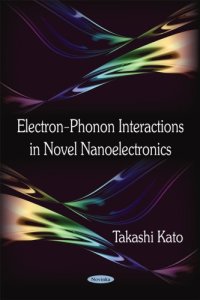
Ebook: Electron-Phonon Interactions in Novel Nanoelectronics
Author: Takashi Kato
- Genre: Technique // Nanotechnology
- Year: 2009
- Publisher: Nova Science Publishers Inc
- Language: English
- pdf
In this book, the electron-phonon interactions in the charged molecular systems such as polyacenes, polyfluoroacenes, B, N-substituted polyacenes, and polycyanodienes are discussed. They estimated the electron-phonon coupling constants and the frequencies of the vibronic active modes playing an essential role in the electron-phonon interactions in order to discuss how CH-CF, CC-BN, and CC-CN substitutions are closely related to the essential characteristics of the electron-phonon interactions in these molecules by comparing the calculated results for charged polyacenes with those for charged B, N-substituted polyacenes and polycyanodienes, respectively. The C-C stretching modes around 1500 cm-1strongly couple to the highest occupied molecular orbitals (HOMO), and the lowest frequency modes and the C-C stretching modes around 1500 cm-1 strongly couple to the lowest unoccupied molecular orbitals (LUMO) in polyacenes. The C-C stretching modes around 1500 cm -1strongly couple to the HOMO and LUMO in polyfluoroacenes. The B-N stretching modes around 1500 cm -1 strongly couple to the HOMO and LUMO in B, N-substituted polyacenes. The C-C and C-N stretching modes around 1500 cm-1 strongly couple to the HOMO and LUMO in polycyanodienes. The total electron-phonon coupling constants for the mono cations and mono anions decrease with an increase in molecular size in polyacenes, polyfluoroacenes, B, N-substituted polyacenes, and polycyanodienes. In general, we can expect that mono cations and mono anions, in which number of carriers per atom is larger, affords larger value. The CH-CF, CC-BN, and CC-CN atomic substitutions are effective way to seek for larger values, and the CH-CF and CC-CN atomic substitutions are effective way to seek for larger values in polyacenes. The logarithmically averaged phonon frequencies which measure the frequencies of the vibronic active modes playing an essential role in the electron-phonon interactions for the mono cations and mono anions in polyacenes, polyfluoroacenes, B, N-substituted polyacenes, and polycyanodienes are investigated. The values decrease with an increase in molecular size in polyacenes, polyfluoroacenes, and polycyanodienes, and the values decrease with an increase in molecular size in polyacenes, polyfluoroacenes, B, N-substituted polyacenes, and polycyanodienes. The authors can expect that in the hydrocarbon molecular systems, the values would basically decrease by substituting hydrogen atoms by heavier atoms. This can be understood from the fact that the frequencies of all vibronic active modes in polyacenes downshift by H-F substitution. However, considering that the value for the LUMO rather localized on carbon atoms in large sized polyfluoroacenes becomes larger by H-F substitution, the authors can expect that the value for a molecular orbital localized on carbon atoms has a possibility to increase by substituting hydrogen atoms by heavier atoms if the phase patterns of the molecular orbital do not significantly change by such atomic substitution. Therefore, the detailed properties of the vibrational modes and the electronic structures as well as the molecular weights are closely related to the frequencies of the vibronic active modes playing an important role in the electron-phonon interactions in the mono anions of polyfluoroacenes.
Download the book Electron-Phonon Interactions in Novel Nanoelectronics for free or read online
Continue reading on any device:

Last viewed books
Related books
{related-news}
Comments (0)